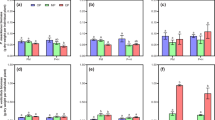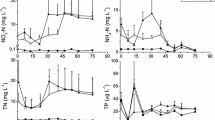Abstract
Increased nutrient loading is regarded as one of the major causes of a shift from macrophyte to phytoplankton dominance in shallow lakes. This work investigates the responses of phytoplankton and epiphyton biomass, macrophytes and algal species assemblages along a trophic gradient in some shallow Mediterranean lakes. A unimodal response of epiphyton biomass to increasing phosphorus levels was observed, while phytoplankton developed exponentially and submerged aquatic plant coverage decreased. At TP levels above 100 μg L−1 (~30 μg-P L−1 by element) phytoplankton began to dominate over the other primary producers and led the system to a turbid state, mainly dominated by cyanobacteria. This could be regarded as a critical threshold to avoid algal turbid states, especially for shallow Mediterranean lakes. Macrophyte typology was also important in modulating this response. On average, the unimodal maximum of epiphyton biomass was about 20 μg g−1 of macrophyte dry weight and hydrophytes had higher epiphytic biomass than helophytes. The coverage of submerged aquatic vegetation was not related to the epiphytic and phytoplanktonic biomass, but to the distribution of their species. Further studies on epiphyton-plant ecology are needed, especially for specific aquatic macrophyte conservation and lake management.





Similar content being viewed by others
References
Allen HL (1971) Primary productivity, chemo-organotrophy, and nutritional interactions of epiphytic algae and bacteria on macrophytes in the littoral of a lake. Ecological Monographs 41:97
Anderson MJ (2001) A new method for non-parametric multivariate analysis of variance. Austral Ecology 26:32–46
Antón B, Romo S, Villena MJ (2013) Diatom species composition and indices for determining the ecological status of coastal Mediterranean Spanish lakes. Anales Jard Bot Madrid 70:122–135
APHA (2009) Standard methods for the examination of water and wastewater. General Books, Washington, p 1129
Bachmann RW, Horsburgh CA, Hoyer MV, Mataraza LK, Canfield DE (2002) Relations between trophic state indicators and plant biomass in Florida lakes. Hydrobiologia 470:219–234
Bécares E, Gomá J, Fernández-Aláez M, Fernández-Aláez C, Romo S, Miracle MR, Ståhl-Delbanco A, Hansson L-A, Gyllström M, Bund WJV, de Donk EV, Kairesalo T, Hietala J, Stephen D, Balayla D, Moss B (2008) Effects of nutrients and fish on periphyton and plant biomass across a European latitudinal gradient. Aquatic Ecology 42:561–574
Blanco S, Bécares E (2006) Método de muestreo de diatomeas epífitas en lagunas para la aplicación de la Directiva Marco del Agua. Tecnología del Agua 26:42–47
Blanco S, Romo S, Villena M-J (2004) Experimental study on the diet of mosquitofish (Gambusia holbrooki) under different ecological conditions in a shallow lake. International Review of Hydrobiology 89:250–262
Blanco S, Romo S, Fernández-Aláez M, Bécares E (2008) Response of epiphytic algae to nutrient loading and fish density in a shallow lake: a mesocosm experiment. Hydrobiologia 600:65–76
Blanco S, Cejudo-Figueiras C, Álvarez-Blanco I, Van Donk E, Gross EM, Hansson L-A, Irvine K, Jeppesen E, Kairesalo T, Moss B, Nõges T, Bécares E (2014) Epiphytic diatoms along environmental gradients in Western European shallow lakes. CLEAN – Soil Air Water 42:229–235
Canfield DE, Shireman JV, Colle DE, Haller WT, Watkins CE II, Maceina MJ (1984) Prediction of chlorophyll a concentrations in Florida lakes: importance of aquatic macrophytes. Canadian Journal of Fisheries and Aquatic Sciences 41:497–501
Carignan R, Kalff J (1982) Phosphorus release by submerged macrophytes: significance to epiphyton and phytoplankton. Limnology and Oceanography 27:419–427
Cattaneo A, Galanti G, Gentinetta S, Romo S (1998) Epiphytic algae and macroinvertebrates on submerged and floating-leaved macrophytes in an Italian lake. Freshwater Biology 39:725–740
Cejudo-Figueiras C, Álvarez-Blanco I, Bécares E, Blanco S (2010) Epiphytic diatoms and water quality in shallow lakes: the neutral substrate hypothesis revisited. Marine and Freshwater Research 61:1457–1467
Den Hartog C, Segal S (1964) A new classification of the water-plant communities. Acta Botanica Neerlandica 13:367–393
Gross EM (2003) Allelopathy of aquatic autotrophs. Critical Reviews in Plant Sciences 22:313–339
Gross EM, Feldbaum C, Graf A (2003) Epiphyte biomass and elemental composition on submersed macrophytes in shallow eutrophic lakes. Hydrobiologia 506–509:559–565
Hammer Ø, Harper D, Ryan P (2001) PAST: paleontological statistics software package for education and data analysis. Palaeontologia Electronica 4
Hansson L-A (1992) Factors regulating periphytic algae biomass. Limnology and Oceanography 37:322–328
Hansson L-A (1996) Algal recruitment from lake sediments in relation to grazing, sinking, and dominance patterns in the phytoplankton community. Limnology and Oceanography 41:1312–1323
ISO (1992) ISO 10260:1992 - Water quality - Measurement of biochemical parameters - Spectrometric determination of the chlorophyll-a concentration
James C, Fisher J, Russell V, Collings S, Moss B (2005) Nitrate availability and hydrophyte species richness in shallow lakes. Freshwater Biology 50:1049–1063
Jeppesen E, Sondergaard M, Sondergaard M, Christofferson K (2012) The structuring role of submerged macrophytes in lakes. Springer, New York, p 423
Jones RC (1984) Application of a primary production model to epiphytic algae in a shallow, eutrophic lake. Ecology 65:1895
Kornijów R (1998) Quantitative sampler for collecting invertebrates associated with submersed and floating-leaved macrophytes. Aquatic Ecology 32:241–244
Kornijów R, Kairesalo T (1994) A simple apparatus for sampling epiphytic communities associated with emergent macrophytes. Hydrobiologia 294:141–143
Kosten S, Lacerot G, Jeppesen E, Marques D, da M, Nes EH, van Mazzeo N, Scheffer M (2009) Effects of submerged vegetation on water clarity across climates. Ecosystems 12:1117–1129
Kosten S, Jeppesen E, Huszar VLM, Van Nes EH, Peeters ETHM, Scheffer M (2011) Ambiguous climate impacts on competition between submerged macrophytes and phytoplankton in shallow lakes. Freshwater Biology 56:1540–1553
Lalonde S, Downing JA (1991) Epiphyton biomass is related to lake trophic status, depth, and macrophyte architecture. Canadian Journal of Fisheries and Aquatic Sciences 48:2285–2291
Legendre P, Legendre L (2012) Numerical ecology. Elsevier, Amsterdam, p 859
Liboriussen L, Jeppesen E (2003) Temporal dynamics in epipelic, pelagic and epiphytic algal production in a clear and a turbid shallow lake. Freshwater Biology 48:418–431
Liboriussen L, Jeppesen E (2006) Structure, biomass, production and depth distribution of periphyton on artificial substratum in shallow lakes with contrasting nutrient concentrations. Freshwater Biology 51:95–109
Mahdy A (2014) Top-down and bottom-up effects in shallow lake food webs with special emphasis on periphyton. Freie Universität Berlin, Berlin, p 96
McDougal RL (2002) Algal primary production in prairie wetlands: the effects of nutrients, irradiance, temperature and aquatic macrophytes. Ph. D. Diss. University of Manitoba, Winnipeg, 305 pp
Miltner RJ, Rankin AET (1998) Primary nutrients and the biotic integrity of rivers and streams. Freshwater Biology 40:145–158
Mitchell SF (1989) Primary production in a shallow eutrophic lake dominated alternately by phytoplankton and by submerged macrophytes. Aquatic Botany 33:101–110
Moreno-Madriñán MJ (2010) Analysis of limnological variables associated to water quality in lakes of northwestern Hillsborough County, Florida. The Florida Scientist 73:218–224
Moss B (1976) The effects of fertilization and fish on community structure and biomass of aquatic macrophytes and epiphytic algal populations: an ecosystem experiment. Journal of Ecology 64:313
Moss B (1981) The composition and ecology of periphyton communities in freshwaters II Inter-relationships between water chemistry, phytoplankton populations and periphyton populations in a shallow lake and associated experimental reservoirs (“Lund tubes”). British Phycological Journal 16:59–76
Moss B, Stephen D, Balayla DM, Bécares E, Collings SE, Fernández-Aláez C, Fernández-Aláez M, Ferriol C, García P, Gomà J, Gyllström M, Hansson LA, Hietala J, Kairesalo T, Miracle MR, Romo S, Rueda J, Russell V, Ståhl-Delbanco A, Svensson M, Vakkilainen K, Valentín M, Van de Bund WJ, Van Donk E, Vicente E, Villena MJ (2004) Continental-scale patterns of nutrient and fish effects on shallow lakes: synthesis of a pan-European mesocosm experiment. Freshwater Biology 49:1633–1649
Özkan K, Jeppesen E, Johansson LS, Beklioglu M (2010) The response of periphyton and submerged macrophytes to nitrogen and phosphorus loading in shallow warm lakes: a mesocosm experiment. Freshwater Biology 55:463–475
Phillips GL, Eminson D, Moss B (1978) A mechanism to account for macrophyte decline in progressively eutrophicated freshwaters. Aquatic Botany 4:103–126
Pinto P, O’Farrell I (2014) Regime shifts between free-floating plants and phytoplankton: a review. Hydrobiologia 740:13–24
Pozo R, Fernández-Aláez C, Fernández-Aláez M (2011) The relative importance of natural and anthropogenic effects on community composition of aquatic macrophytes in Mediterranean ponds. Mari Freshwat Res 62(2):101–109
Romo S, Galanti G (1998) Vertical and seasonal distribution of epiphytic algae on water chestnut (Trapa natans). Archiv fur Hydrobiologie 141:483–504
Romo S, Miracle MR, Villena M-J, Rueda J, Ferriol C, Vicente E (2004) Mesocosm experiments on nutrient and fish effects on shallow lake food webs in a Mediterranean climate. Freshwater Biology 49:1593–1607
Romo S, Villena M-J (2005) Phytoplankton strategies and diversity under different nutrient levels and planktivorous fish densities in a shallow Mediterranean lake. Journal of Plankton Research 27:1273–1286
Romo S, Villena M-J, García-Murcia A (2007) Epiphyton, phytoplankton and macrophyte ecology in a shallow lake under in situ experimental conditions. Fundamental and Applied Limnology Archiv fur Hydrobiologie 170:197–209
Sand-Jensen K, Borum J (1991) Interactions among phytoplankton, periphyton, and macrophytes in temperate freshwaters and estuaries. Aquatic Botany 41:137–175
Scheffer M, Hosper SH, Meijer, ML, Moss B, Jeppesen E (1993) Alternative equilibria in shallow lakes. TREE 8(8):275–279
Scheffer M, Rinaldi S, Gragnani A, Mur LR, van Nes EH (1997) On the dominance of filamentous cyanobacteria in shallow, turbid lakes. Ecology 78:272–282
Ståhl-Delbanco A, Hansson L-A, Gyllström M (2003) Recruitment of resting stages may induce blooms of Microcystis at low N:P ratios. Journal of Plankton Research 25:1099–1106
StatSoft I (2011) STATISTICA for Windows (data analysis software), Version 10.0
Trigal C, Fernandez-Alaez C, Fernandez-Alaez M (2014) Congruence between functional and taxonomic patterns of benthic and planktonic assemblages in flatland ponds. Aquatic Sciences 76:61–72
Utermöhl H (1958) Zur Vervollkommnung der quantitativen Phytoplankton-Methodik. Mitteilungen Internationale Vereinigung fur Theoretische und Angewandte Limnologie 9:1–38
Villena M-J, Romo S (2007) Effects of nutrients, fish, charophytes and algal sediment recruitment on the phytoplankton ecology of a shallow lake. International Review of Hydrobiology 92:626–639
Whitley DC, Ford MG, Livingstone DJ (2000) Unsupervised forward selection: a method for eliminating redundant variables. Journal of Chemical Information and Modeling 40:1160–1168
Zhang Y, Thas O (2012) Constrained ordination analysis in the presence of zero inflation. Statistical Modelling 12:463–485
Zimba PV, Hopson MS (1997) Quantification of epiphyte removal efficiency from submersed aquatic plants. Aquatic Botany 58:173–179
Acknowledgments
This research was funded by the Spanish Ministry of Science and Technology project REN2003-03718. We thank all the collaborators in the project for their inestimable help during field samplings and laboratory analyses. We are grateful to Prof. Brian Moss and two anonymous reviewers for their valuable comments on the manuscript.
Author information
Authors and Affiliations
Corresponding author
Rights and permissions
About this article
Cite this article
Blanco, S., Romo, S., Cejudo-Figueiras, C. et al. Modelling Primary Producers in Some Shallow Spanish Lakes. Wetlands 36, 649–658 (2016). https://doi.org/10.1007/s13157-016-0775-2
Received:
Accepted:
Published:
Issue Date:
DOI: https://doi.org/10.1007/s13157-016-0775-2




